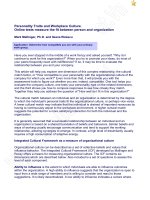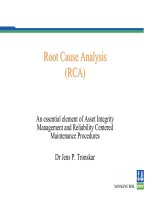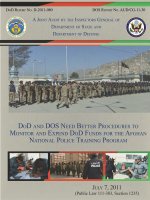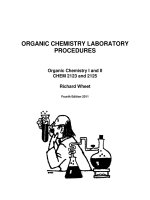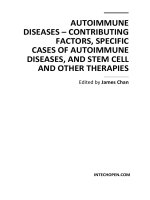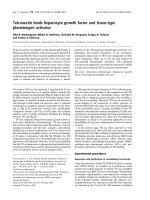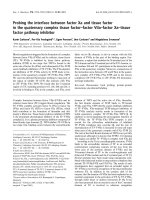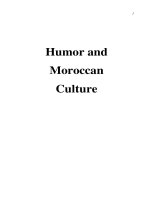Cell and tissue culture laboratory procedures alan doyle
Bạn đang xem bản rút gọn của tài liệu. Xem và tải ngay bản đầy đủ của tài liệu tại đây (49.42 MB, 354 trang )
~ d i t e dby
The ~ e l l c o ~
Trust,
e
London, UK
and
S ~ i e n t i ~ c ~ o n s u l ~and
a n cpublish
y
in^
Porton
S~lisbu~y,
UK
Singapore * Toronto
Copyright 0 1998 by John Wiley & Sons Ltd,
Baffins Lane Chichester,
West Sussex P019 1UD, England
National
779777
01243
International
(+44)
1243
779777
e-mail (for orders and customer services enquiries): cs-books~wiley.co.nk
Visit our Home Page on http:/lwww.wiley.co.uk
or
Reprinted September 1999
All Rights Reserved. No part of this publication may be reproduced,
stored in a retrieval system, or transmitted, in any form or by any means,
electronic, mechanical, photocopying, recording, scanning or otherwise, except
under the terms of the Copyright, Designs and Patents Act 1988 or under the
terms of a licence issued by the Copyright Licensing Agency,
90 Tottenham Court Road, London, UK WlP 9HE, without the permission in
writing of the publisher, The editors and contributors have asserted their right,
under the Copyright, Designs and Patents Act 1988, to be identified as the editors
of and contributors to this work.
Other Wiley ~ ~ i t ~ rOjjLices
ial
John Wiley & Sons, Inc., 605 Third Avenue,
New York, NY 10158-0012, USA
WILEY-VCH Verlag GmbH, Pappelallee 3,
D-69469 Weinheim, Germany
Jacaranda Wiley Ltd, 33 Park Road, Milton,
Queensland 4064, Australia
John Wiley & Sons (Asia) Pte Ltd, 2 Clementi Loop #02-01,
Jin Xing Distripark, Singapore 129809
John Wiley & Sons (Canada) Ltd, 22 Worcester Road,
Rexdale, Ontario M9W 1L1, Canada
~ i b r oaf ~Congress Cataloging-jn-~~blication
Data
Cell and tissue culture :laboratory procedures in biotechnology I
edited by Alan Doyle & J. Bryan Griffiths.
cm.
p.
Includes bibliographical references and index.
ISBN 0-471-98255-5 (alk. paper)
1. Cellculture-Laboratorymanuals.
2. Tissue cultureLaboratory manuals. 1. Doyle, Alan. 11. Griffiths, J. B.
~P248,2S.C44C448 1998
660.6'028-dc21
98-24068
CIP
r i t i s ~~ i b r C~talog~ing
u ~
in ~ ~ b l i c a t i oData
n
A catalogue record for this book is available from the British Library
ISBN 0 471 98255-5
Cover photograph: Electron micrograph courtesy of Mr A.B. Dowsett and Dr T. Battle.
CAMR Porton Down, Salisbury UK.Rat hepatocytes in vitro.
Typeset in 10112pt Times by The Florence Group, Stoodleigh, Devon
Printed and bound in Great Britain by Biddles Ltd, Guildford, UK.
This book is printed on acid-free paper responsibly manufactured from sustainable forestry, in which
at least two trees are planted for each one used for paper production.
Contents
Contributors
Foreword
Preface
Safety
CHAPTER 1 THE CELL: SELECTION AND STANDARDIZATION
1.1
Overview
References
1.2
Cell Lines for Biotechnologists
Introduction
Cell line CHO dhfrCell line Sf9
Cell line Schneider-2
Cell lines COS 1/COS 7
Cell line NIH3T3
Cell line HeLa
Cell line J558L
Cell line Vero
Myeloma cell lines
Hybridomas
Cell line MRC-5
Cell line WI-38
Cell line Namalwa
Cell line BHK-21
Cell line MDCK
Cell line GH3
Cell line 293
Cell line !VCRE/!VCRIP
References
1.3
Master and Working Cell Banks
Scale and composition of cell banks
Extended cell bank
The cell banking environment and procedures
Features required for GLP procedures
Conclusion
References
xiii
xviii
XiX
xx
1
3
4
5
5
5
6
7
7
8
8
9
9
10
10
11
11
12
12
13
13
13
15
15
18
20
20
20
21
22
24
v1
1.4
1.5
1.6
1.7
1.8
1.9
CELL AND TISSUE CULTURE
Identity Testing - An Overview
Cytogenetic analysis
Isoenzyme analysis
DNA fingerprinting and DNA profiling
References
DNA Fingerprinting
PRELIMINARY PROCEDURE: Probe preparation
PROCEDURE: Hybridization
Discussion
References
Detection of Mycoplasma
PROCEDURE: DNA stain
ALTERNATIVE PROCEDURE: Use of indicator
cell lines
SUPPLEMENTARY PROCEDURE: Microbiological culture
SUPPLEMENTARY PROCEDURE: Elimination of
contamination
Discussion
Ref ereiices
Mycoplasma Detection Methods using PCR
PROCEDURE:Amplification
SUPPLEMENTARY PROCEDURE: Analysis of
amplified samples
Discussion
References
Bacteria and Fungi
PROCEDURE: Detection of bacteria and fungi in
cell cultures
Discussion
References
Elimination of Contamination
PROCEDURE: Eradication
Discussion
References
CHAPTER 2 CELL QUANTIFICATION
Overview
2.1
References
Haemocytometer Cell Counts and Viability Studies
2.2
PROCEDURE: Haemocytometer cell count
Discussion
MTT Assay
2.3
PROCEDURE: MTT assay - suspension or monolayer cells
ALTERNATIVE PROCEDURE: MTT assay immobilized cells
References
25
25
26
26
27
29
29
30
31
34
35
36
39
39
40
40
41
42
43
44
45
46
47
47
49
49
50
50
50
52
53
55
56
57
58
59
62
62
63
64
t
L
vii
CONTENTS
2.4
2.5
2.6
CHAPTER 3
3.1
3.2
3.3
3.4
Neutral Red (NR) Assay
PROCEDURE:Neutral red assay
SUPPLEMENTARY PROCEDURE:Protein assay
SUPPLEMENTARY PROCEDURE:Bioactivation
SUPPLEMENTARY PROCEDURE:UV radiation
References
LDH Assay
PROCEDURE:Measurement of LDH activity
Discussion
References
Miniaturized Colorimetric Methods for Determining
Cell Number
PRELIMINARY PROCEDURE:Pretreatment of cells
PRELIMINARY PROCEDURE:96-Well cell growth
or toxicity assays
PRELIMINARY PROCEDURE:Trypan blue exclusion
method for cell viability estimation
PROCEDURE:Colorimetric assays: general
introduction
Discussion
References
65
66
68
68
69
70
71
71
73
74
CULTURE ENVIRONMENT
Overview
References
Serum-free Systems
Elimination of serum
Serum substitution
Discussion
References
Adaptation to Serum-free Culture
PRELIMINARY PROCEDURE:Method for
selecting serum
PRELIMINARY PROCEDURE: Method for
selecting nutrient medium
PRELIMINARY PROCEDURE:Types of serum-free
media
Modifying the nutrient medium
PROCEDURE:Method for adapting cells to serum-free
medium
Discussion
References
Amino Acid Metabolism
PROCEDURE:Amino acid analysis
Case study
References
83
85
86
87
88
88
90
91
92
76
76
77
77
78
80
80
93
94
94
95
96
97
98
100
101
106
107
...
Vlll
3.5
3.6
3.7
CELL AND TISSUE CULTURE
Tissue Culture Surfaces
The treatment process
Stability
Bioactivity
Surface choice and comparison
Microcarriers
Porous membrane systems
Discussion
References
Plastic and Glass Tissue Culture Surfaces
PROCEDURE:A simple procedure for coating surfaces
References
Three-dimensional Cell Culture Systems
Spheroids
Microcarriers
Filterwells
Matrix sponges or three-dimensional gels and matrix
sandwiches
Microcontainers
Simulated microgravity
Conclusion
References
CHAPTER 4 BIOCHEMISTRY OF CELLS IN CULTURE
4.1
Overview
Quantitative Analysis of Cell Growth, Metabolism and
4.2
Product Formation
Errors in calculations
Cell growth and death rates
Cell metabolism
Product formation
Concluding remarks
Acknowledgements
References
Modelling
4.3
Background for the modelling of mammalian cell cultures
Method for kinetic model construction
Use of the model for the evaluation of rate-limiting factors
Discussion
References
Background reading
Cell Death in Culture Systems (Kinetics of Cell Death)
4.4
PROCEDURE: Morphological characterization of cell
death
PROCEDURE: Biochemical characterization of cell
death
109
109
110
111
111
112
113
114
114
116
118
120
121
122
123
124
124
124
125
125
125
129
131
133
134
134
144
156
157
159
159
160
160
163
174
175
178
175
179
180
182
ix
CONTENTS
Purification of
apoptotic cells
Discussion
References
Detoxification of Cell Cultures
PROCEDURE: Detoxification by dialysis
ALTERNATIVE PROCEDURE: Detoxification by
gel filtration
Discussion
References
Oxygenation
PROCEDURE:Measurement of oxygen transfer
coefficient and oxygen uptake rate
SUPPLEMENTARY PROCEDURE:Oxygenation
methods
References
Mixing
Assessing cell damage
Parameters used to correlate cell damage due to
agitation and/or air sparging
Cultures of freely suspended cells
Anchorage-dependent cells (microcarrier cultures)
References
Mechanical Protection
PRELIMINARY PROCEDURE: Additive preparation
PROCEDURE: Testing before using an additive
Additives for freely-suspended cells
Additives for microcarrier cultures
References
203
204
206
208
210
211
211
212
216
216
CULTURE PROCESSES AND SCALE-UP
Overview
Scale-up factors
Scale-up strategies
General principles
Monolayer and suspension culture
Culture modes
Biological factors
Summary
References
Roller Bottle Culture
PROCEDURE: Roller bottle culture of animal cells
Comment
Supplementary procedures
Discussion
Background reading
219
221
222
222
224
224
225
225
226
227
228
228
229
229
230
230
SUPPLEMENTARY PROCEDURE:
4.5
4.6
4.7
4.8
CHAPTER 5
5.1
5.2
183
184
185
187
187
188
189
189
190
191
194
198
202
202
X
5.3
5.4
5.5
5.6
5.7
5.8
5.9
CELL AND TISSUE CULTURE
Spinner Flask Culture
PROCEDURE:Culture of suspension cells in a
spinner flask
Discussion
Background reading
Pilot-scale Suspension Culture of Hybridomas an Overview
Pilot- and large-scale in vitro systems for hybridomas
Cultivation modes
References
Pilot-scale Suspension Culture of Human Hybridomas
PROCEDURE:Optimization of culture parameters
and scaleup
Inoculuni preparation and optimization of parameters
Discussion
References
Chemostat Culture
Equipment
Method
Discussion
References
Growth of Human Diploid Fibroblasts for Vaccine
Production Multiplate Culture
PROCEDURE:Propagation and subcultivation of
human diploid cells in 150-cm’ plastic culture vessels
PROCEDURE:Seeding, cultivation, trypsinization and
infection of a Nunc 6000-cm2 multiplate unit
Discussion
References
Background reading
Microcarriers - Basic Techniques
PRELIMINARY PROCEDURE:Siliconization
PROCEDURE:Growth of cells on microcarriers
Discussion
References
Background reading
Porous Microcarrier and Fixed-bed Cultures
PRELIMINARY PROCEDURE:Initial preparation
and calibration of equipment
PROCEDURE: Assembly Of culture vessels
PROCEDURE:System set-up
PROCEDURE:Inoculation and maintenance of
culture system
SUPPLEMENTARY PROCEDURE: Analysis O f
consumption and production rates in the fixed-bed
porous-glass-sphere culture system
231
231
234
234
235
235
237
238
240
240
241
243
245
246
248
248
251
251
254
254
255
259
261
261
262
264
265
266
266
267
268
212
272
274
274
275
xi
CONTENTS
5.10
CHAPTER 6
6.1
SUPPLEMENTARY PROCEDURE: Termination Of
culture and determination of cell numbers
Discussion
References
Control Processes
Basic process control
Enhanced control of physicalkhemical parameters
Enhanced control of cell metabolism
Discussion
References
REGULATORY ISSUES
Regulatory Aspects of Cells Utilized in Biotechnological
Processes
Cell line derivation
Recombinant cells
Cell characterization studies
References
277
278
280
282
282
285
288
290
290
293
295
296
297
298
299
CONCLUDING REMARKS
Productivity
301
301
APPENDIX k TERMINOLOGY
Some aspects of the problem
Solutions to the problem
Terminology associated with cell, tissue and organ
culture, molecular biology and molecular genetics
References
305
305
306
APPENDIX 2: COMPANY ADDRESSES
315
APPENDIX 3: RESOURCE CENTRES FOR BIOTECHNOLOGISTS
325
Index
329
306
313
This Page Intentionally Left Blank
Mohamed AI-Rubeai
University of Bir~ingham,School of Chemical Engineering, Centre for
Biochemical Engineering, Birmingham B15 2TT, UIC
Section: 2.3
arvey Babich
Stern College for Women, ~ e p a r t m e n of
t Biology, 245 Lexington Avenue,
New York, NY 10016, USA
Section: 2.4
,Salisbury, Wiltshire SP4 OJC, UK
Section: 3.7
ordeaux 11, Laboratoire de acteriologie,
146 rue Leo Saignat,
33076 France
Section: 1.7
Section: 3.4
Ellen Borenfreund
The Rockefeller University, Laboratory Animal Research Center,
LARC Box 2, 1230 York Avenue, New York, NY 1001214399, USA
Section: 2.4
Michael C. Borys
Northwestern University, ~ e p a r t m e n of
t Chemical Engineering,
2145 Sheridan Road, Evanston, IL 60208, USA
Sections: 4.6 & 4.7
Pharmacia & Upjohn AB, Strandbergsgatan 47,
S-112-87 Stockholm, Sweden
Section: 3.4
XiV
Barbara Clough
National Institute for Medical
Section:1.2
CELL AND TISSUE CULTURE
Research, Mill Hill, London NW7 3.AA, U
Martin Clynes
National Cell and Tissue Culture Centre, Bioscience Ireland, School of
Biological Sciences, Dublin City University, Clasnevin, Dublin
9, Ireland
Section: 2.6
Thomas C . Cotter
Department of Biochemistry, University College Cork, Lee Maltings,
Prospect Row, Cork, Ireland
Section: 4.4
Irene Cour
American Type Culture Collection, Cell Culture ~epartment,
PO Box 1549, Manassas, Virginia 20108 3 549, USA
Section:1.8
National Cell and Tissue Culture Centre, Bioscience Ireland,
School of Biological Sciences, Dublin City University, Glasnevin, Dublin
Ireland
Section: 2.6
9,
o g r a m ~ eManager, Joint I~frastructureFund, The ~ e l l c o Trust,
~e
oad, London NW1 2BE, UIS
Sections: 1.1, 1.3, 1.4, 1.6, 3.1, 3.6 & 6.1
Jean-Marc Engasser
Institut National Polytechni~uede Lorraine, Laboratoire des Sciences du Genie
S- SIC-~NSAIA, B P 451, 1 Rue Crandville, 54001
Cedex, France
Section: 4.3
Jean-Louis Coergen
Institut National ~olytechniquede Lorraine, Laboratoire des Sciences du Genie
S-ENSIC-E~SAIA, BP451, 1 Rue Grandville, 54001 Nancy
Cedex, France
Section: 4.3
Harry E. Gray IT1
~ e c t o n - ~ i c k i n s oLabware,
n
Biological Science and Technology,
~ ~ v e l o p ~ e1n tecton
,
Drive, Franklin Lakes, NJ07417-1886, USA
Section: 3.5
J. Bryan Griffiths
Scientific Consultancy & Publishing, 5 Bourne Gardens, Porton, Salisbury,
~ i l t s ~ i SP4
r e ONU, UK
Sections: 1.4, 2.1, 3.6, 4.1, 5.1, 5.2, 5.3, 5.8 & 5.9
Director, Cell Biology, American Type Culture Collection,
ox 1549, ana ass as, Virginia 20108 1549, USA
Section: 1.8
ivision, Sandwic~,Kent CT13 9NJ, UK
wena James
Ltd, 2A Orchard Road, Royston S 6 8 5
a r ~ a ~ e Laboratories
ne
Section: 2.2
ak Park, Bedford, MA 01.730, USA
S~ction:3.5
accine ~ ~ s t i t uPt ~ ,
atories I r ~ l a ~~ i~n,i s k l i l ~ ~ n ~ u sEstate,
trial
Section: 4.4
atoire des Sciences
G r a ~ ~ ~ i 54001
lle,
Cedex, France
Section: 4.3
xvi
CULTURE
CELL AND TISSUE
Angela Martin
National Cell and Tissue Culture Centre, Bioscience Ireland, School of
Biological Sciences, Dublin City University, Glasnevin, Dublin 9, Ireland
Section: 2.6
Jennie P. Mather
Genentech Inc., 460 San Bruno Boulevard, San Francisco, CA 94080, USA
Section: 3.2
Mary Mazur-Melnick
Connaught Labs Ltd, 1775 Steeles Avenue West, Willowdale, Ontario M24 3T4,
Canada
Section: 5.7
William M. Miller
Northwestern University, Robert R.McCormick School of Ellgineering and
Applied Science, De~artmentof Chemical Engineering, 2145 Sheridan Road,
~ v a n s t o IL
~ , 60208-3120, USA
Section: 4.2
Jon Mowles
Biochem Trnmuno Systems UK Ltd, 20 Woking Business Park, Albert Drive,
Woking 61121 5JU, UK
Sections: 1.6 & 1.9
T. Ohno
Riken Gene Bank, 3-1-1 Koyadoi, Uatabe, Tsukuba, Ibaraki 305, Japan
Section: 1.6
Eleftherios T. Papoutsakis
Northwestern University, D ~ ~ a r t m e of
n t Chemical Engineering,
oad, Evanston, IL 60208, USA
Sections: 4.6, 4.7 & 4.8
Andrew Racher
LONZA Biologics plc, 228 Bath Road, Slough, Berkshire SL1 4Dy, UK
Section: 2.5
Sridhar Reddy
Associate Scientist, Cell Genesys, Inc., 322 Lakeside Dr., Foster City, CA 94404
USA
Section: 4.2
ystein R ~ n ~ i n g
~ p t ~ f AS,
l o Olaf
~ Helsets Vei 6, N-0621 Oslo, Norway
Section: 4.5
xvii
~ONTRI~~TO~S
Winfried Scheirer
Novartis Forschungsininstitut GmbH, Cellular/~olecular
Biology, PO Box 80,
Brunner Strasse 59, A-l235 Vienna, Austria
Section: 5.10
Ulrich Schuerch
Swiss Serum and Vaccine
Sections: 5.4. & 5.5
Institute, CH 3001, Berne, Switzerland
Glyn Stacey
NIBSC, Blanche Lane, South ~ i m m sPotters
,
Bar EN6 3QG, UK
Sections: 1.3, 1.5, 3.7 & 6.1
R. Teyssou
Universitk de Bordeaux 11, Laboratoire de Bacteriologie, 146 rue Leo Saignat,
33076 France
Section: 1.7
Mary C. Tsao
Genentech Inc., 460 San Bruno Boulevard, San Francisco, CA 94080, USA
Section: 3.3
Sally war bur to^
ECACC, CAMR, Salisbury, Wiltshire SP4 OJG, UK
Section: 2.2
Kristina Zachrisson
P~armaciaand Upjohn AB, Strandbergsgatan 47, S-112-87 Stockholm, Sweden
Section: 3.4
uring the last 20 years we have witnessed the extraordinary impact of biotec
nology inthe academic researchlaboratoryand
in industry.Not only hasit
provided a stimulus for the creation of a large number of companies in the new
biotechnology industry, but it has
also been a catalyst for new approaches in
existing industries.Theresulthasbeen
the development of many, important,
new methods of diagnosis andtherapy in hum
hcareand, increasingly, new
approaches to solving problemsinagriculture.theseapplicationsrepresent
the tangible and often remarkable end products of biotechnology, it is clear that
their develo~mentwould not have been possible without the development of an
lly remarka~learray of new manufacturing technologies and laborato~ytools.
lthinthe biotechnologist’s toolkit, animal cell culture has come to play a
~articularlyprominent role. In the pharmaceutical industry,cell culture is used to
produce a significant pro~ortionof biopharmaceuticals as well asmonoclonal antibodies for diagnostic use. In addition, the use of animal cells is expanding in a
wide range of other applications: drug screening,tissue en~ineering,gene therapy,
ology and traditional applications such as virology.
early the practical application of animal cell culture has to be underpinned
la~oratoryprotocols.
There
s i g ~ i ~ c number
~nt
of cell
thatare used across thebroad
of cell culture a~plications
industrial
and laboratori
ently
there
are several
e used to solve a given
his ~ ~ b l i c a t i oprovides
n
convenient acces
S s u ~ hthe
, book will be useful to a wide r
heir awarenessof th
applied cell culture.
make it a useful a~junct to traini~g
programmes inthe cell culture laboratory.
Thecomprehensivemanual
‘Cell and Tissue Culture:LaboratoryProcedures’
.Griffiths and D.G. Newell, was first published in 1993,
with quarterly additions and updates up to 1998. The publication has been well
received by the scientific community and has now reached completion. Numerous
requests have been received from a range of people, saying: ‘When will a series
of subset volumes be produced?’ In response to this demand we have decided to
look afresh at the wealth of material available in the main publication and adapt
from this ‘highlights’,whichwe believe will be of particular value to targeted
users. The first of these is the subset for biotechnologists, which contains selected
es that provide essential technical infor~ationfor this group of scienof the contributions have been updated from the original for this
publication. It is certainly not our intention to reproduce all of the manual in
this fashion but to provide core procedures for each of the specialist groups that
can. be identified as benefiting from them. We aim to appeal to scientists who may
be new to cell culture and require the practical guidance that ‘Cell and Tissue
Culture: Laboratory Procedures’ has to offer. There is also the added benefit of
the valuable technical information being available without the major investment
in the whole publication. e believe that these subsets will fulfil a need and we
look forward to preparing further publications along these lines,
Neither the editors, contributors nor John Wiley & Sons Ltd. accept any responsibility or liability for loss or damageoccasioned to any person or property through
using the materials, instructions, methods, or ideas contained herein, oracting or
refraining from acting as a result of such use. While the editors, contributors and
publisher believe that the data, recipes, practical procedures and other information, as set forth in this book, are in accord with current recommendations and
practice at the t h e of publication, they accept no legal responsibility for any
errors or omissions, and make no warranty, express or implied, with respect to
material contained herein. Attention to safety aspects is an integral part of all
laboratory procedures and national
legislations impose legal requirements on those
persons planning or carrying out such procedures. It remains the responsibility of
the reader to ensure that the procedures which are followed are carried out in a
safe manner and thatall necessary safety instructions and national regulations
are
implemented.
In viewof ongoing research, equipment modifications and changes in governmental regulations, the reader is urged to review and evaluate the information
provided by the manufacturer, for each reagent,piece of e~uipmentor device, for
any changes in the instructions or usage and for added warnings and precautions.
This Page Intentionally Left Blank
The biotechnologist has a wealthof systems to choose frombefore the decision has
to be taken to establish a cell line for a specific purpose de novo.
requirements(andnot
least the
llectual Property consideratio
the ‘utility?of esisting material.
so, if the cells for esploitati
in vitro syst
lready exist, then authentic
tools tocreatethe
starting material are essential. This can mean o b t a i n ~ gcell stoc
such as ECACC, ATCC,
ken
3.2). The advantage of ba
ect
ed and~uality-controlledstocks cannot be over
advantage is that much of the material available from collections is free of
raints on exploitation.
e standards for the cryopreservation, storage and routine quality control of
cell stocks are widely recognized (Stacey et al., 1995). Cryopreservation of a wellcharacterized, de~endable,high-viability (achieved by controlled-rate free~ing),
microbial-contaminent-free cell stock is f ~ n d a m e n t a ~t o boththeacademic
researcherwell
asas
commercial
the
p
lation provides for a
set of international standards
the
and
S to Consider9 are
the
in this field (
y aspects are dealt
seen asbenchmark
within
more detail in section 1.3 andChapter
6. Unfortunately, scientists
e m ~ a r k e don a research programme leading to a cell line that might be esploitable
at some later stage do not necessarily regard such guidelines as relevant to them
or to the goals of their work. This is a narrow view and one that is potentially
expensive and has to be dispelled at all costs.
further consideration is the safety aspect of handling cell lines, The minimum
standard to be applied in any cell culture laboratory is Categor 2 containment.
sk assessment is made, in most cases theesteacteri~ation
wledge on the potential hazard of handling
material is
unk~own.This is especiallytrue with respect to thepresence of adventitious
(e.g.
viruses)
cell
lines.
in
There may
concern in the hand
patient material with regard to hepatit
status and a balanced view
on risk has to be taken. The topic is a
to say that once minimum standards are set they can be all-embracing for every
cell type handled.
f articular importance in the routine handling of cell cultures is the
plasma contamination statusof cell lines.If present, the concentration of mycoplasmas in the culture supernatant can be in the region of 106-108 mycoplasmas ml-l.
Unlike bacterial and fungal contaminants, they do not necessarily manifest themselvesin terms of p change andlor turbidity and they canbe present inlow
Cell and Tissue Culture: ~ a b o r ~ tProcedures
~ry
in ~ i o t ~ c ~ n o ledited
o ~ y , by A.Doyle and J.B. Griffiths.
0 1998 John Wiley & Sons Ltd.
4
THE
SELECTION
AND
CELL:
STANDARDI~ATION
numbers. ~ycoplasmaselicit numerous deleterious effects and their presence is
incompatible with standard~edsystems. Routinely,brothand
agar cultureor
echst DNA stain are the methods of choice for detection, althoughincreasingly
ymerase chain reaction(PCR)methods
are becoming available (Doyle &
olton, 1994). Tests have to be part of a regular routine and not just seen
as ‘oneoff‘ procedures at the start of a piece of work. Elimination of contamination is
possible but costly in time and resources, and
is not always successful,so it is better
to check early rather than later;
this re-emphasizes the importanceof authenticated
cell banks to return toin case of contaminatio~.
Finally, it must be emphasized that no amount of testing can replace the dayto-day vigilance of laboratory workers routinely ha~dlingcells. Any alteration in
normal growth pattern or morphology should not be ignored because this may
well indicate a fundamental problemwell in advance of other more formaltesting
parameters.
StaceyG,DoyleA & Ham~letonP(eds)
Centre
Biologics
for Evaluation
and
tur~.
(1998) Safety in ~ i s s ~ e C ~ lKluwer,
search (CBER) (1993), ~ u i n t s to
London.
nsider in Characteri~utionof Cell Lines
used to ~ r o d ~Biulo~icals.
ce
US Food and Stacey, GN, Parodi, B & Doyle, AJ (1995)
TheEuropeanTissueCultureSociety
Drugs ~dministration,Bethesda,
(ETCS) initiative on quality control
of cell
olton BJ (1994), The quality
lines. ~ x p e r i ~ ~ in
n t sClinical
Cuncer
control of cell lines and the prevention,
~esearch:4: 210-211.
detection and cure of contamination, In:
Basic Cell Culture: U ~ r a ~ t i c a l ~ p p r o a c h ,
pp. 243-271. IRL Press, Oxford.
nimal cell lines have beenused extensivelyfor the productionof a variety of therapeutic and prophylactic protein products including hormones, cytokines, enzymes,
antibodies and vaccines. They offer the advantage of reproducibility and convenience over primary cell cultures and animal models as well as the
large-scale production. In addition, animal cells are generally capable of secreting
functionally active proteins correctly folded and with correct ~ost-translational
modifications, unlike bacterial or yeast systems. In the production of recombinant
proteins, fidelity in glycosylationof the product can be an important
consideration
in~uencingits secretion, degradation and biologicalactivity. Comparisons have
been made between glycosylation of recombinant proteins using insect, bacterial
and mammalian expression systems, which have highlighted differences between
these and the human glycosylation profile (James et al., 1995). The adaptation of
many cell lines to growth in serum/protein-~reemedia has facilitated not only the
dow~streamprocessing of the secreted product but also minimi~es thepotential
risk of viral and mycoplasma contaminants, which can beinadvertently added with
animal sera or animal-d~rivedproteins such as growth factors.
Furt~ermore,m a ~ ~ a l i acell
n lines transfecte~with a variety of exp~ession
systems have been widelyused for the expression of recombinant rotei ins of
commercial and therapeutic importance, some of which will be addressed here
(see Table 1.2.1).
Certain cell lines require licensing agreements for their usein c
production, although for research and development applications this is
ally necessary.
